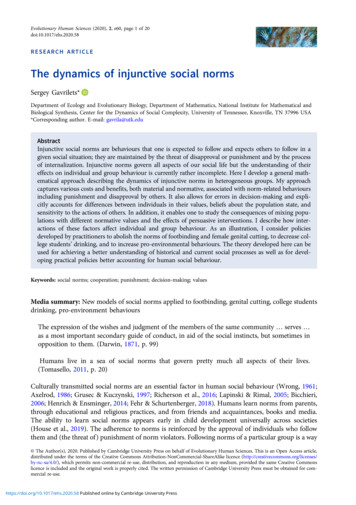
Transcription
Evolutionary Human Sciences (2020), 2, e60, page 1 of 20doi:10.1017/ehs.2020.58RESEARCH ARTICLEThe dynamics of injunctive social normsSergey Gavrilets*Department of Ecology and Evolutionary Biology, Department of Mathematics, National Institute for Mathematical andBiological Synthesis, Center for the Dynamics of Social Complexity, University of Tennessee, Knoxville, TN 37996 USA*Corresponding author. E-mail: gavrila@utk.eduAbstractInjunctive social norms are behaviours that one is expected to follow and expects others to follow in agiven social situation; they are maintained by the threat of disapproval or punishment and by the processof internalization. Injunctive norms govern all aspects of our social life but the understanding of theireffects on individual and group behaviour is currently rather incomplete. Here I develop a general mathematical approach describing the dynamics of injunctive norms in heterogeneous groups. My approachcaptures various costs and benefits, both material and normative, associated with norm-related behavioursincluding punishment and disapproval by others. It also allows for errors in decision-making and explicitly accounts for differences between individuals in their values, beliefs about the population state, andsensitivity to the actions of others. In addition, it enables one to study the consequences of mixing populations with different normative values and the effects of persuasive interventions. I describe how interactions of these factors affect individual and group behaviour. As an illustration, I consider policiesdeveloped by practitioners to abolish the norms of footbinding and female genital cutting, to decrease college students’ drinking, and to increase pro-environmental behaviours. The theory developed here can beused for achieving a better understanding of historical and current social processes as well as for developing practical policies better accounting for human social behaviour.Keywords: social norms; cooperation; punishment; decision-making; valuesMedia summary: New models of social norms applied to footbinding, genital cutting, college studentsdrinking, pro-environment behavioursThe expression of the wishes and judgment of the members of the same community serves as a most important secondary guide of conduct, in aid of the social instincts, but sometimes inopposition to them. (Darwin, 1871, p. 99)Humans live in a sea of social norms that govern pretty much all aspects of their lives.(Tomasello, 2011, p. 20)Culturally transmitted social norms are an essential factor in human social behaviour (Wrong, 1961;Axelrod, 1986; Grusec & Kuczynski, 1997; Richerson et al., 2016; Lapinski & Rimal, 2005; Bicchieri,2006; Henrich & Ensminger, 2014; Fehr & Schurtenberger, 2018). Humans learn norms from parents,through educational and religious practices, and from friends and acquaintances, books and media.The ability to learn social norms appears early in child development universally across societies(House et al., 2019). The adherence to norms is reinforced by the approval of individuals who followthem and (the threat of) punishment of norm violators. Following norms of a particular group is a way The Author(s), 2020. Published by Cambridge University Press on behalf of Evolutionary Human Sciences. This is an Open Access article,distributed under the terms of the Creative Commons Attribution-NonCommercial-ShareAlike licence ), which permits non-commercial re-use, distribution, and reproduction in any medium, provided the same Creative Commonslicence is included and the original work is properly cited. The written permission of Cambridge University Press must be obtained for commercial re-use.https://doi.org/10.1017/ehs.2020.58 Published online by Cambridge University Press
2Sergey Gavriletsto maintain and enhance one’s social identity (Tajfel & Turner, 1979). Social norms are a foundationof well-functioning communities and the glue that keeps society together. They vary dramaticallybetween different groups (Gelfand et al., 2011); there is also substantial variation in their effects onindividuals within groups (Atran & Ginges, 2013). Certain norms are internalized, that is, actingaccording to a norm becomes an end in itself rather than merely a tool in achieving certain goalsor avoiding social sanctions (Henrich & Ensminger, 2014; Gavrilets & Richerson, 2017). For individuals who have strongly internalized a norm, violating it is psychologically painful even if the directmaterial benefits for the violation are positive (Mu et al., 2015). Such individuals will also tend to criticize or punish norm violators (Cooter, 2000). Many individuals and groups are willing to payextremely high costs to enact, defend or promulgate norms that they consider important (Atran &Ginges, 2013). At the same time, virtually all norms can be violated by individuals under some conditions (e.g. if the costs of compliance are too high; Lapinski et al., 2017). Society’s norms are affectedby historical and environmental factors, with some societies being more successful than others owingto their norms and institutions (Morris, 2015; Turchin, 2016). Some norms are very stable while otherscan change rapidly. Understanding the emergence, persistence and effects of social norms, values andbeliefs is vital not only from a fundamental research perspective but also for implementing variouspolicies aiming to improve human life.The concept of social norms varies across disciplines (Bicchieri, 2006; Young, 2008, 2015; Nyborg,2018). In social psychology, the two most common definitions are those of the descriptive and injunctive norms (Cialdini et al., 1990). Descriptive norms involve perceptions of which behaviours are typically performed and what people actually do. In contrast, injunctive norms are behaviours that one isexpected to follow and expects others to follow in a given social situation, that is, they refer to whatpeople ought to do even if doing so is against their immediate interests. Injunctive norms are viewed asbeing sustained by the threat of social disapproval/punishment for norm violations and/or by norminternalization (Bicchieri, 2006). This makes them different from ‘conventions’ (Lewis, 1969) forwhich there is a continuity between the individual’s self-interest and the interests of the communitythat supports the convention (Bicchieri, 2006; Young, 2008).Game theory and evolutionary game theory, which are the most appropriate theoretical frameworksfor studying social interactions, focus almost exclusively on descriptive norms and conventions. In standard evolutionary game theory approaches to norms (e.g. Young, 2015), one starts with a population ofinteracting players who initially use different strategies/actions. The players update their strategies/actionsattempting to maximize the payoffs. In the deterministic limit, the population then converges to a locallystable equilibrium (often one of several possible) at which everybody uses the same strategy – a norm.[According to Young (1998, p. 821), a norm ‘is, in short, an equilibrium of a game.’] Metaphorically(and mathematically, if one uses the replicator equation for modelling the dynamics) a norm then isjust a strategy that has won a competition with other strategies. With stochasticity added, there willbe some distribution of strategies around a particular mean strategy.Such approaches however are not directly applicable for modelling injunctive norms as they do notconsider explicitly human expectations about approval, disapproval or punishment, or internalizedvalues of certain acts. They also usually neglect heterogeneity between individuals in their internalvalues or sensitivity to (dis)approval by others. However, all of these characteristics and propertieshave been demonstrated to be important in human decision-making (Chung & Rimal, 2016;Shulman et al., 2017) and must be considered when planning and implementing social policies targeting certain types of behaviour.There are exceptions though. For example, ‘threshold models’ allow for heterogeneity between individuals in how their decision-making is affected by previous actions of others (e.g. Rashevsky 1949,1951, 1965a, 1965b; Granovetter, 1978; Neary & Newton, 2017; Efferson et al., 2020). Akerlof(1980) explicitly considers reputation and the loss of utility owing to disobeying a code of honour.Bernheim (1994) allows for a normative value of status. Azar (2004) and Akcay and van Cleve(2020) consider a normative value of conformity with the most common behaviour, and Gavriletshttps://doi.org/10.1017/ehs.2020.58 Published online by Cambridge University Press
Evolutionary Human Sciences3and Richerson (2017) and Nyborg (2018) include the value of social approval by others in their models of social norms. Here I will follow and extend this approach.Below, using recent advances in cultural evolution theory, I will build a simple general mathematical framework describing the dynamics of injunctive social norms. I will explicitly account for normative values of certain behaviours, for the effects of passive or active approval and disapproval byothers, and for heterogeneity of individuals with respect to normative values and beliefs. I will doso by integrating the classical Schelling–Granovetter model of collective behaviour (Schelling, 1971;Granovetter, 1978) with a recent approach by Gavrilets and Richerson (2017) to modelling socialnorm internalization. The Schelling–Granovetter model explicitly accounts for heterogeneity betweenindividuals in their reaction to groupmates’ behaviour. This model has been applied to a number of‘behavioural contagion’ phenomena including residential segregation and mass protests. TheGavrilets–Richerson model explicitly accounts for both material and normative effects on humanbehaviour, for within-group heterogeneity in these effects and for errors in human decision-making.Gavrilets and Richerson (2017) showed how the ability to internalize norms can evolve on evolutionary, i.e. macro, timescales. Here instead I will assume that this ability is already present and that thebehaviour of individuals is already affected by certain normative values and costs they assign to certainacts or situations.Specifically, I will study the dynamics of human behaviour in heterogeneous groups on relativelyshort time-scales during which the distribution of normative values in the group is approximatelystable. My focus will be on two questions that are very important from both theoretical and practicalperspectives: how do interactions of material factors, normative values and the expectation of (dis)approval or punishment by others affect individual and group behaviour, and how one can leverageour knowledge about these interactions to achieve certain social goals. In spite of their simplicity,my models exhibit rich dynamics which I study using both analytical approximations and numericalbifurcation analysis. I will illustrate the applicability and generality of my approach by using severalexamples of successful and unsuccessful attempts to modify social norms in various target populations.ResultsModelsI will consider two different types of models. The models of ‘passive disapproval’ show how norms canbe maintained merely by the expectation that norm violators are disapproved by others. In models of‘passive and active disapproval’, I add costly acts of disapproval and punishment. In both cases, I willfocus on the joint effects of material and normative consequences of different acts while allowing forheterogeneity between individuals. I will keep the mathematical complexity of the model at aminimum.Passive disapproval of norm violatorsConsider a very common situation: you need to cross the street, there are no cars or police around, butthe crosswalk sign says ‘don’t walk’ and there are several people waiting for it to change. You know youare supposed to wait. You also expect that if you break the norm and cross the street, the bystanderswill likely disapprove of you. However, you are in a rush. What do you do?To approach this question theoretically, consider a focal individual who can either follow theinjunctive norm and wait for the crosswalk light to turn green (x 1) or jaywalk (x 0). [In the modelsbelow, an injunctive norm is a behaviour to which at least some individuals assign some positive normative value.] Let b be the expected net material benefit of crossing the street rather than waiting. (Theparameter b can also account for a cost of being observed by the police or being hit by a car whenjaywalking.) Let v be an intrinsic benefit of following the norm and v the intrinsic cost of violatingit. The net normative value v v v can be viewed as the strength of norm internalization (Gavrilets& Richerson, 2017). Let p be the focal individual’s estimate of the frequency of such people, e.g. basedhttps://doi.org/10.1017/ehs.2020.58 Published online by Cambridge University Press
4Sergey Gavriletson previous observations. I posit that an individual violating the norm assumes that others who dofollow it disapprove of his behaviour if they observe it (Fehr & Schurtenberger, 2018). The anticipateddisapproval imposes an internal psychic cost on the norm violator even if the disapproval carries nodirect cost. Assuming that this psychic cost increases with the anticipated number of people who disapprove, I define it as κp, where parameter κ is the maximum normative cost of passive disapproval byothers. Then the utility of following the norm is u1 v while that of violating it is u0 b v κp.The individual is predicted to comply with the norm if u1 u0 which is equivalent to a condition thattheir normative value v v* where a threshold v* for compliance isv b kp.(1)Note that an individual with a low normative value v relative to the potential material benefit b will stillcomply with the norm if the expected normative cost of disapproval κp is high enough. The latterincreases with the estimated frequency p of people following the norm.Consider now a population of individuals repeatedly and simultaneously facing the same dilemma.If all individuals are identical in their material and normative values and costs b, v, κ and everybody isable to estimate the previous frequency p of norm-compliant types and utilities u without errors,everybody will make the same decision and the population will move to a state with p 0 or p 1in just one step. That is, the norm will not be obeyed at all or everybody will comply.Naturally, individuals in the population can differ in b, v, κ, and their estimates of p. Let the normative value of compliance v have a certain distribution in the population with the correspondingcumulative distribution function (c.d.f.) F (z). For now, assume that all individuals have exactly thesame values of b and κ and are able to estimate p precisely. Given b, κ and p, the frequency of individuals with v v*, who, thus, will not comply, is F (v*). Therefore, the frequency of individuals whowill choose to comply with the norm isp′ 1 F(b kp).(2)Recursive equation (2) describes the dynamics of p in the population. Frequency p always evolves to anequilibrium. The equilibrium values of p can be found from the equality p* 1 F (b κp*). There canbe several equilibria and which one is eventually approached depends on initial conditions. An equilibrium p* is locally stable if κf (b κp*) 1 and is unstable otherwise. Here f is the probability densityfunction corresponding to F (i.e. f dF/dv). Given a specific c.d.f. F, one can study the correspondingdynamics analytically, graphically or numerically. A particularly illuminating method, which I will usebelow, is to plot ‘bifurcation diagrams’ which summarize the dependence of equilibria and theirstability of parameters and initial conditions.Uniform distribution of v. Assume first that v has a uniform distribution between 0 and vmax.Assume also that b vmax (so that no one is willing to comply if nobody else is doing it, i.e. if p 0)and that κ b (so that, everyone complies if everybody else is complying, i.e. p 1). Then there is a threshmaxold initial frequency p̃ b vkvmax , and the population will converge to a state where the norm is lost (i.e. p 0) if the initial frequency of compliance p p̃, but it will ‘fix’ it (i.e. p 1) if p p̃ (see the SupplementaryInformation, SI). Decreasing the normative cost of disapproval κ or increasing material benefit b of notcomplying decreases p̃ and makes fixing the norm easier. In this model, the population quickly becomeshomogeneous in its behaviour in spite of substantial variation in individual preferences.Log–normal distribution of v. Alternatively, assume that the distribution of v is log–normal withmean v and variance σ 2 (see the SI). One cannot find the equilibria of equation (2) and checktheir stability explicitly but it is straightforward to do it numerically.Figure 1 shows the corresponding equilibrium values of p for different values of the average normative value v̅ , normative cost κ and standard deviation σ. [In the terminology of the dynamical systems theory (e.g. Glendinning, 1994), each subgraph in this figure is a ‘bifurcation diagram’ with σbeing a ‘bifurcation parameter’.] The graphs show that the norm can be stably maintained at highhttps://doi.org/10.1017/ehs.2020.58 Published online by Cambridge University Press
Evolutionary Human Sciences5Figure 1. Equilibrium values of frequency p for the model with passive disapproval of norm violators (predicted by equation (2))when the distribution of v in the group is lognormal with mean v̅ and standard deviation σ. Different columns correspond to different values of v̅ . Different rows correspond to different values of the maximum cost of disapproval κ. Standard deviation σ is usedas the bifurcation parameter. Filled diamonds are stable equilibria. Open diamonds are unstable equilibria separating the twostable ones. Parameter b is set to 1 without loss of generality.frequencies and that the system can have up to two locally stable equilibria separated by an unstableone. Multiple equilibria seem to appear if v̅ κ b v̅ and σ is small enough. Even with a high averagenormative value of compliance v̅ , the population can still be at the no-norm state (e.g. top row, right,where v̅ 0.9, but p is close to 0). Alternatively, even with a low average normative value v̅ the population can still exhibit high compliance (e.g. the bottom row, left, where v̅ 0.4, but p is close to 1). Thestability of these equilibria is assured by the self-fulfilling expectation of disapproval by the majority ofothers. Increasing standard deviation σ increases the norm frequency p if v̅ is low, but can decrease itwhen v̅ is large. Increasing the normative cost κ of (passive) disapproval increases the likelihood ofmultiple equilibria. Figures S2 and S3 in the SI explore the dependence of equilibrium values of pon v̅ and κ in more details.The location and stability of equilibria also depend on the shape of the distribution of v in thepopulation. Figures S4–S6 in the SI show the corresponding bifurcation diagrams for three additionaldistributions of v: a normal distribution, a Laplace distribution and a logistic distribution, respectively.Although the overall patterns are similar, the specific values of parameters at which the structure ofequilibria change can be different.All four distributions of v considered so far were unimodal. Figure S7 in the SI corresponds to abimodal distribution of v which may describe a situation when the focal population is a mix of twohttps://doi.org/10.1017/ehs.2020.58 Published online by Cambridge University Press
6Sergey Gavriletssubgroups with different distributions of normative values. Note that bimodal distributions of normative values within a single population was predicted in Gavrilets and Richerson’s (2017) evolutionarymodel while Kimbrough and Vostroknutov (2016) demonstrated it empirically in an experimentaleconomic game. In the case of bimodal distributions there can be up to three simultaneously stableequilibria. When the two subgroups are close to each other in their values, the structure of equilibriais naturally similar to that when the distribution of v is unimodal. At intermediate distances betweenthe two subgroups and small σ, there appears a new equilibrium close to p 0.5. At larger distances,the range of existence and stability of this equilibrium greatly expands while those of equilibria withsmall and large p shrink. Convergence to equilibria is typically quite fast – a few time steps – asillustrated in Figures S8–S10 in the SI.Several conclusions emerge from these analyses: Unpopular norms (i.e. norms with low v̅ ) can be stably maintained in the population whereasgenerally preferred norms (i.e. norms with high v̅ ) can be present at very low frequencies.Both these outcomes are related to a notion of ‘preference falsification’ (i.e. the act of communicating a preference and/or performing an action that differs from one’s true preference underperceived social pressure, Kuran (1989)). Parameters and initial conditions have strong effects on the eventual population state. Thisimplies that different groups can diverge in their state even if they are subject to similar socialforces. Also important is the shape of the distribution of individual values/beliefs in the population. Predicting the population social dynamics requires a good knowledge of this distribution. All this means that different groups/cities/communities may find themselves at different equilibria owing to differences in initial conditions even if everything else is the same. Moreover,groups/cities/communities can differ in parameter values (costs, benefits, etc.) and in the distribution of normative values. These differences will affect the outcomes of social dynamics. The variance σ 2 of the distribution of normative values has nonlinear effects on the frequency ofnorm-abiding behaviour p: increasing σ can increase or decrease p depending on other parameters. Also, larger σ typically means slower convergence to an equilibrium. Small and/or slow changes in parameters (which, for example, can be brought by some policyinterventions) can cause a quick and dramatic change in the population. Similar effects maybe caused by stochastic forces. A prerequisite for dramatic changes is the existence of simultaneously stable equilibria. Changes in individual and group behaviour can be achieved by changing material benefits and costs(e.g. b), normative values (e.g. v and κ) or by changing the expectation of what others do (e.g. theirestimate of p), e.g. by providing/manipulating certain information. An ‘injection’ of certain information can shift the population to the domain of attraction of a different equilibrium.Errors in utility evaluation. So far I have assumed that individuals made no errors in evaluatingutilities. To capture possible errors, one can use the quantal response equilibrium approach, whichgeneralizes classical Nash equilibria (Goeree et al., 2016). Other ways to describe errors are possibleand have received considerable attention (Young, 1998). The advantage of the quantal response equilibrium is that in this approach error probabilities depend on error costs. Figure S11 in the SI showsthat decreasing precision causes the disappearance of equilibria with relatively small domains of existence and attraction and shifts the remaining solution branch towards 0.5 as individuals tend to maketheir decision more randomly. Overall, errors in decision-making, which are largely unavoidable inmost realistic situations, can have a significant impact on the structure of equilibria by shifting ptowards intermediate values.Effects of population mixing. Stable maintenance of social norms in groups and communities can beendangered by the influx of individuals who do not share the corresponding normative values. Letm be a proportion of individuals in the whole population for whom v k 0, so that they arehttps://doi.org/10.1017/ehs.2020.58 Published online by Cambridge University Press
Evolutionary Human Sciences7motivated only by material factors. Let F be the c.d.f. of v in the remaining part of the population and pbe the frequency of individuals following the norm among in that part. Then the observed frequencyof the normative behaviour in the whole population is (1 m)p. The dynamics of p are described bythe equationp′ 1 F(b k(1 m)p).(3)Figure 2 shows that norms are relatively stable to a small infusion of newcomers but the frequency ofnorm followers p can be significantly reduced if m is sufficiently large.Effects of persuasive interventions. Certain norms stably maintained in groups and societies seriouslyendanger the well-being of individuals (e.g. footbinding, female genital cutting or excessive drinkingin college students; see below). There is a significant effort to develop different interventions aiming toeliminate such norms. The model considered in the previous section can also be interpreted asdescribing a situation when a random proportion m of people have their normative values reset tozero as a result of some kind of a persuasive intervention. Figure S2 then shows that such interventionscan be effective. Rather than being applied to a random sample of individuals, some intervention practices can target certain subsets of individuals. For example, persuading individuals least committed tothe norm (i.e. with the smallest normative values) to permanently abandon the norm is probably theeasiest. On the other hand, targeting individuals most committed to the norm (i.e. with the highestnormative values) may potentially have the largest effect. In terms of our model, a successful intervention transforms the original distribution of v into a distribution truncated on one side or another (seethe SI). Figure S12 in the SI illustrates the resulting effects on equilibrium values of p when the intervention targets a proportion m of individuals with the highest values of v. The effects are significantalthough, of course, persuading such individuals who are highly committed to the norm to abandon itis most difficult. In contrast, Figure S13 in the SI shows that targeting ‘low-hanging fruit’ individuals(i.e. with the smallest v) has no significant effect. Similar conclusions were reached in a recent paper byEfferson et al. (2020) who used a model of conformity.Other costs and benefits. My approach can be generalized to other costs and benefits. For example,individuals can not only suffer (passive) disapproval from others when violating the norm but alsoenjoy (passive) approval from those who follow the norm (e.g. if particular acts are perceived asbeing associated with an identity group the individuals identity with, e.g. Pryor et al., 2019). Thiscan be captured by adding an extra term to the utility of following the norm so that it becomesu1 v vap, where va is the maximum normative values of (passive) approval. The only effect ofthis modification is that the threshold normative value for compliance becomes v* b (κ va)p.Individuals are often motivated by a general desire to conform with the majority (Cialdini &Goldstein, 2004; Pryor et al., 2019). A simple way to model this is to add a normative value vc(1 p)to u0 and vcp to u1, respectively, where vc is a parameter measuring the strength of conformity.This change will result in a compliance threshold v* b vc (κ 2vc)p. One can also allow forthe material benefit of abandoning the norm to be frequency-dependent. For example, in the caseof the footbinding norm (see below), not binding girls’ feet brings health benefits but can also resultin reduced mating opportunities. One can capture this effect by subtracting terms cf p and cf (1 p)terms from utilities u0 and u1, respectively, where cf is the corresponding cost parameter. With thismodification, v* b cf (κ 2cf )p. Naturally all these additional costs and benefits can be present simultaneously which would modify v* accordingly.Variation in other characteristics. The approach can be used if individuals differ not in a normativevalue v they assign to following the norm but in some other characteristics. For example, if individualsdiffer in how sensitive they are to (normative) cost of disapproval κ which has a c.d.f. F (z) in thepopulation, then there is a threshold value for compliance κ* (b v)/p and the recurrence equationhttps://doi.org/10.1017/ehs.2020.58 Published online by Cambridge University Press
8Sergey GavriletsFigure 2. Equilibrium values of frequency p in the model of population mixing (equation 3). Green, red and black diamonds correspond to three different values of the immigration rate: m 0.2, 0.1, and 0, respectively. Filled diamonds are stable equilibria.Open diamonds are unstable equilibria separating the two stable ones. b 1.for p becomes p′ 1 F ((b v)/p). Figure S14 in the SI gives an example of the corresponding bifurcation diagrams.Both passive and active disapproval of norm violatorsSo far I have assumed that norm violators experienced only passive disapproval. Now assume that aftermaking a decision about complying (i.e. choosing x 1) or not (i.e. choosing x 0) with the norm,individuals can also actively disapprove (or punish) norm violators, e.g. by verbally admonishingthem (or just rolling their eyes or raising eyebrows). [Here, the difference between passive and activedisapproval is that the latter is costly to the individuals expressing it.] The injunctive norm now is toboth follow the prescribed behaviour and actively disapprove of norm violators; its normative value isdenoted v as above. Let variable y 0 and y 1 specify the act of disapproval and let q be the frequencyof individuals doing it. Then the utility of complying with the
The dynamics of injunctive social norms Sergey Gavrilets* Department of Ecology and Evolutionary Biology, Department of Mathematics, National Institute for Mathematical and Biological Synthesis, Center for the Dynamics of Social Complexity, University of Tennessee, Knoxville, TN 37996 USA *Corresponding author. E-mail: gavrila@utk.edu Abstract Injunctive social norms are behaviours that one is .










